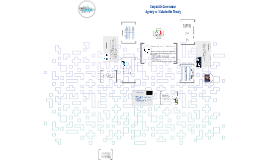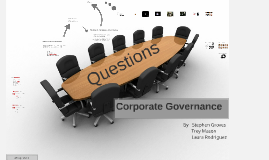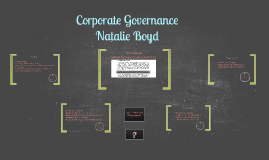Corporate Governance
Transcript: Corporate Governance Agency vs Stakeholder Theory Officers (Managers) The Agency Theory Possible Improvements Corporate governance refers to the mechanisms and processes by which corporations are controlled. This includes: Determining the company’s goals. Selecting processes and people to pursue this goal. Regular evaluations. Proper communication between those involved. Stewardship Theory Institutional Theory Resource Dependence Theory Managerial Hegemony Theory Stakeholder Once again, groups of 5 Different situation with different criteria. Try and find the optimal solution!!! References Carney, M., Gedajlovic, E., & Sur, S. (2011). Corporate governance and stakeholder conflict. Journal of Management & Governance, 15(3), 483-507. Jensen, M. C. (2010). Value maximization, stakeholder theory, and the corporate objective function. Journal of Applied Corporate Finance, 22(1), 32-42. doi:10.1111/j.1745-6622.2010.00259.x Werder, A. (2011). Corporate governance and stakeholder opportunism. Organization Science, 22(5), 1345-1358. Yeh, C., & Taylor, T. (2008). Issues of governance in sport organisations: A question of board size, structure and roles. World Leisure Journal, 50(1), 33-45. Zeitoun, H., Osterloh, M., & Frey, B. S. (2014). Learning from ancient Athens: Demarchy and corporate governance. Academy of Management Perspectives, 28(1), 1-14. Stakeholder Officers (Managers) Other Governance Theories *All possible solutions require some sort of combination of both perspectives. (Zeitoun, Osterloh, & Frey, 2014) Shareholders The Stakeholder Theory Board of Directors (Werder, 2011) (Carney, Gedajlovic, & Sur, 2011) Corporate Governance - A Quick Review Situation #2 Discussion Time The Enlightened Stakeholder Theory The stakeholder theory with the long-term goal of maximizing market value (Jensen, 2010). Dual Boards of Directors One BOD representing the shareholders and the other representing the stakeholders (Zeitoun, Osterloh, & Frey, 2014). Etc... Stakeholder What were the positives and negatives of this decision making process? The Agency Theory Situation #1 (Yeh & Taylor, 2008) Board of Directors We are going to have a simile "Board of Directors meeting". Please pair up in groups of 5 One person will be Chairman of the Board and will be assigned the task of presenting the scenario and ensuring a solution is found. The others will each be assigned a stakeholder to represent with certain criteria to follow. Shareholders Employees Customers Suppliers Government Community The Stakeholder Theory Clearly, more research is needed to optimize the current theories. Sport managers need to understand the importance of corporate governance and the various theories that pervade it. It will be up to us to remain up to date with current research to ensure the efficient operation of our organizations! Relevance for Researchers and Sport Managers (Jensen,2010)

















